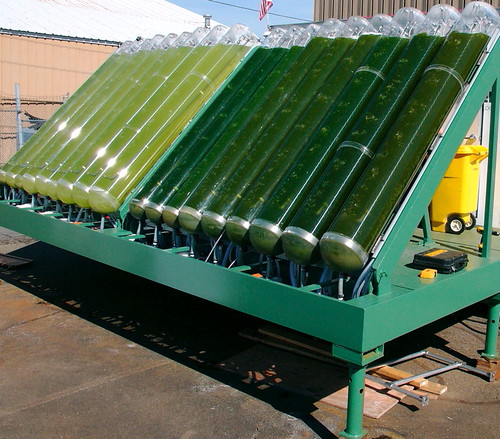 GreenFuel differentiates itself by the technology used for algae adaptation (derived from a NASA project for the International Space Station), a bioreactor design that is inexpensive to manufacture and to operate, and an analytical method for optimally exposing algae to sunlight—all of which have patents pending.
GreenFuel differentiates itself by the technology used for algae adaptation (derived from a NASA project for the International Space Station), a bioreactor design that is inexpensive to manufacture and to operate, and an analytical method for optimally exposing algae to sunlight—all of which have patents pending.Check out this is a photo originally uploaded by jurvetson at flickr.com.

These columns of green algae have been artificially evolved to efficiently consume smokestack pollution (NOx and CO2). Basically they capture CO2 from smokestack emissions using algae, and turn the result into biofuels including biodiesel, ethanol, and even a bio-coal substitute.
"Algae is 25 times better a source for biodiesel than palm oil, and 300 times better than soy."
 Cellulosic Ethanol-a renewable, cleaner-burning, and carbon-neutral alternative to gasoline .
Cellulosic Ethanol-a renewable, cleaner-burning, and carbon-neutral alternative to gasoline .The U.S. Department of Energy (DOE) released an ambitious research agenda for the development of cellulosic ethanol as an alternative to gasoline.
The 200-page scientific roadmap cites recent advances in biotechnology that have made cost-effective production of ethanol from cellulose, or inedible plant fiber, an attainable goal. Cellulosic ethanol is derived from the fibrous, woody portions of plant matter (biomass).
Read more HERE

No comments:
Post a Comment